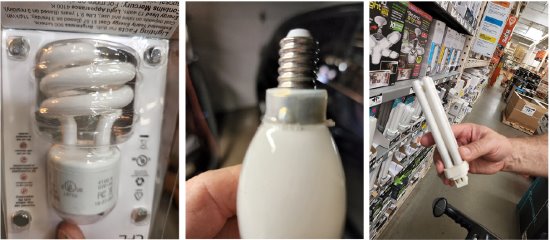| | Published September 28th, 2022
| Shedding light on LED lighting
| | | By Jim Hurley |  | | LED lighting options Photos Jimm Hurley |
One of my goals as a handyman is to help you save money. One of the best money savers for homeowners is to convert their lighting to LED bulbs and fixtures. One of the frequent calls I get is to fix a light that is misbehaving due to the LED update. Hopefully I can shed some light on this.
 Not all light fixtures are created equal. Your home probably has several different kinds of lights: incandescent, fluorescent, condensed fluorescent, halogen, and LED. Let's sort this mess out.
Not all light fixtures are created equal. Your home probably has several different kinds of lights: incandescent, fluorescent, condensed fluorescent, halogen, and LED. Let's sort this mess out.
 The incandescent bulb is the oldest version of lightbulb. (Thank you, Thomas Edison, or was it Joseph Swan? Google Time ...) The bulb is screwed into a socket. Of course, it's not that simple. Sockets come in different sizes: Standard (medium) and Candelabra (small) are most common. I've also encountered Metric-sized/French-thread (Gaggenau hood fans), and Mogul bases (super large for old-fashioned floor lamps) out there. Incandescent bulbs also come in different wattages. Bulb "wattage" has been the standard measurement of how bright the bulb is, (more about that later). By the way, your parents were right, they do burn a lot of electricity, so turn them off when you leave the room.
The incandescent bulb is the oldest version of lightbulb. (Thank you, Thomas Edison, or was it Joseph Swan? Google Time ...) The bulb is screwed into a socket. Of course, it's not that simple. Sockets come in different sizes: Standard (medium) and Candelabra (small) are most common. I've also encountered Metric-sized/French-thread (Gaggenau hood fans), and Mogul bases (super large for old-fashioned floor lamps) out there. Incandescent bulbs also come in different wattages. Bulb "wattage" has been the standard measurement of how bright the bulb is, (more about that later). By the way, your parents were right, they do burn a lot of electricity, so turn them off when you leave the room.
 The second most common fixture in older homes is the fluorescent tube. Fluorescent fixtures are more energy efficient than incandescent bulbs, but still not as efficient as LED. Fluorescent bulbs use less electricity than incandescent to run, but they do use more electricity to start. To save money, leave the fluorescent turned on, rather than turning it on and off when you are at home. The downside to fluorescent lights is they sometimes hum, or flicker, or are just too bright. They are very common in commercial lighting because they are more energy efficient when left on for extended periods of time.
The second most common fixture in older homes is the fluorescent tube. Fluorescent fixtures are more energy efficient than incandescent bulbs, but still not as efficient as LED. Fluorescent bulbs use less electricity than incandescent to run, but they do use more electricity to start. To save money, leave the fluorescent turned on, rather than turning it on and off when you are at home. The downside to fluorescent lights is they sometimes hum, or flicker, or are just too bright. They are very common in commercial lighting because they are more energy efficient when left on for extended periods of time.
 Similar to the long fluorescent bulb is the condensed fluorescent (CF) bulb. These are the bulbs with the glass curlicue, spiral, or prong-like glass tube. Some can be screwed into regular bulb sockets, but many are made with square bottoms that click into the fixture. Replacing them is a fun experience in matching the configuration of the base to the new bulb; two or four pins, clips or tabs. Hint: take the old bulb with you to the hardware store.
Similar to the long fluorescent bulb is the condensed fluorescent (CF) bulb. These are the bulbs with the glass curlicue, spiral, or prong-like glass tube. Some can be screwed into regular bulb sockets, but many are made with square bottoms that click into the fixture. Replacing them is a fun experience in matching the configuration of the base to the new bulb; two or four pins, clips or tabs. Hint: take the old bulb with you to the hardware store.
 Halogen bulbs are small but powerful bulbs that burn very hot. They were popular with designers because they are small, bright and can fit discreetly into small fixtures. They are commonly found in recessed ceiling lights, bookcase "puck-lights," and low voltage garden lights. Halogen bulbs have different bases too. They may have pins that insert into a ceramic block or the GU10 base which clip or twist into the base.
Halogen bulbs are small but powerful bulbs that burn very hot. They were popular with designers because they are small, bright and can fit discreetly into small fixtures. They are commonly found in recessed ceiling lights, bookcase "puck-lights," and low voltage garden lights. Halogen bulbs have different bases too. They may have pins that insert into a ceramic block or the GU10 base which clip or twist into the base.
 LED stands for Light Emitting Diode. This light source runs on very low voltage and is the most efficient light for power consumption. This is the future and I recommend upgrading to LED wherever possible in your home. LED brightness is measured in Kelvin, not Watts. The K factor is an assessment of their "warmth" - 2700K is called "warm white" and resembles the soft glow of an old incandescent bulb. From warm white they range up to 5000K or "Daylight." "Daylight" has a blue brightness to it and is great for dark places like your garage, attics, basements, and closets.
LED stands for Light Emitting Diode. This light source runs on very low voltage and is the most efficient light for power consumption. This is the future and I recommend upgrading to LED wherever possible in your home. LED brightness is measured in Kelvin, not Watts. The K factor is an assessment of their "warmth" - 2700K is called "warm white" and resembles the soft glow of an old incandescent bulb. From warm white they range up to 5000K or "Daylight." "Daylight" has a blue brightness to it and is great for dark places like your garage, attics, basements, and closets.
 Now that we've learned not all bulbs are created equal, neither are light switches. Your standard light switch which toggles on or off can operate with any of the above bulb types. The problems start with dimmer switches. Older dimmer switches may not be compatible with LED lights. How will you know? Sometimes the new LED bulb just refuses to turn on, sometimes it does not shut off completely; sometimes it buzzes and flickers or strobes when you try to dim the light. Some will work at full brightness and only have trouble when dimmed. If these problems arise when you switch to an LED bulb, a good test is to take the dimmer switch out of the junction box and manually complete the circuit. (If you don't know what that means, then you should probably call your handyperson.) If the lights work when you bypass the switch, then you need to buy a new dimmer with LED compatibility. Read the label of the new switch to make sure it is compatible with LED. Also please be aware, that some LED bulbs may not be "dimmable." Non-dimmable bulbs are usually lower priced at the store. Look for the word "Dimmable," (is that really a word?), on the package before buying the bulb, if you intend to use them with a dimmer.
Now that we've learned not all bulbs are created equal, neither are light switches. Your standard light switch which toggles on or off can operate with any of the above bulb types. The problems start with dimmer switches. Older dimmer switches may not be compatible with LED lights. How will you know? Sometimes the new LED bulb just refuses to turn on, sometimes it does not shut off completely; sometimes it buzzes and flickers or strobes when you try to dim the light. Some will work at full brightness and only have trouble when dimmed. If these problems arise when you switch to an LED bulb, a good test is to take the dimmer switch out of the junction box and manually complete the circuit. (If you don't know what that means, then you should probably call your handyperson.) If the lights work when you bypass the switch, then you need to buy a new dimmer with LED compatibility. Read the label of the new switch to make sure it is compatible with LED. Also please be aware, that some LED bulbs may not be "dimmable." Non-dimmable bulbs are usually lower priced at the store. Look for the word "Dimmable," (is that really a word?), on the package before buying the bulb, if you intend to use them with a dimmer.
 Some spouses may say, "they can't even change a light bulb" about their unhandy partners. In light of the complexity of bulbs, bases, and switches discussed above, you might consider cutting your better half some slack.
Some spouses may say, "they can't even change a light bulb" about their unhandy partners. In light of the complexity of bulbs, bases, and switches discussed above, you might consider cutting your better half some slack. |
 | | Jim Hurley is an independent handyman with over 25 years of experience in residential repairs. Hopefully this free advice is helpful to someone attempting Do-It-Yourself home repairs. The information presented is intended for informational purposes and for use by persons having appropriate technical skill, at their own discretion and risk. | | | | | | | | | | | |




